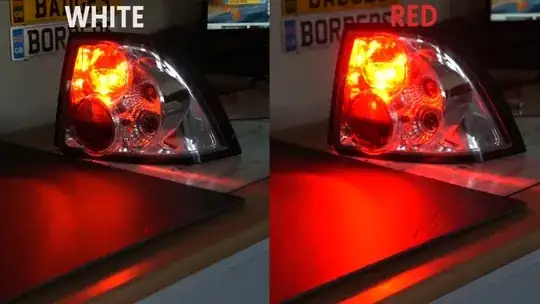I'd sure like to see the numbers here. My guess is the simple answer I often use here to design related questions.
Which design is the least expensive to produce?
My guess is it's the systems cost which is driving things here.
Speaking of LEDs... its not clear if what we see in generic terms holds true for current manufacturing concepts. For example, a SMD (Surface Mount Device) LED deployed in a large matrix flat pack. If you are a manufacturing facility, how would you produce that? There is large demand for white LED's in that format. What about red LEDs? Would you dare introduce that into your manufacturing process, knowing full well that at a glance these LED's look alike? Ugh.
The other piece of the conversation I'm not entirely sure of is the driver circuitry differences between White LED's and Red LEDs. I believe those different LEDs work with different current / voltage drops. That could well lead to differences in the driver chips in use. And that leads to complexity (if introduced within the White LED manufacturing plant...) No problem, just build and tool up a brand new Red LED plant; mixing problem solved (oops. That's expensive)
You never want to introduce a potential quality problem with mixed stock How do you fix that? Well, you would introduce a whole bunch of computer checks and inspections so that never happens. And guess what happens to the prices you would have to charge? That would be ugly.
What we don't know is the prices (cost) here. It would not surprise me that the purchasing groups have leveraged huge piece cost reductions for long range committments for quanity and time. (If we would guarentee a 50 million piece sustained order, would the supplier amortize tooling and reduce piece price, etc...) If you go outside of those bounds (by say introducing red LED's into the mix) that would result with a huge price increase from the supplier. Been there, done that and it is always an ugly conversation.
And yeah, I apologize for going a bit off script here. The actual question above is why not red led's under red lenses. My answer is still the same root response.
For many elements of automotive design, the answer to "Why did they do it that way?" is because of price. When you make millions of vehicles per year, when you save even a few pennies on component piece pricing, those dollars add up.
Follow the money, follow the money, follow the money. (Don't remotely jeapordize quality, but definitely follow the money...)
And its not just the LED / drivers / heatsink costs.
A additional piece of the conversation is plastic raw material and tooling costs.
Red tail lamps use red acyrlic. Clear tail lamps use clear polycarbonate (with a clear coat top spray finish). Acyrlic is a lot cheaper then polycarbonate.
Note too, there are a whole bunch of legal requirements for rear and side marker reflectivity. That stuff is easy to integrate in red molded lenses... but you have to add extra red bits to meet the requirements on a clear taillamp system. And that adds more cost.
With that said, headlamps / LED accents / tail lamps are often a "surprise and delight" visual feature. They add a lot to the visual appearance of a vehicle, and for that the manufacturer may be willing to spend more on piece costs.
